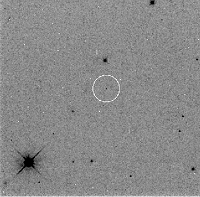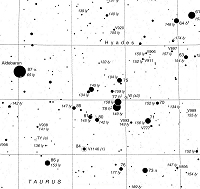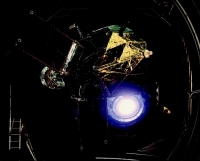Gamma-ray Sources
Mysterious gamma-ray bursts
About twice a day satellites in orbit register a burst of gamma-rays somewhere in the Universe. These bursts may last a hundredth of a second, or anything up to 90 minutes. Some bursts become briefly the brightest objects in the gamma-ray sky. For over twenty years the astronomers hadn't a clue as to how far away these explosions occurred until in early 1997 the Italian-Dutch satellite Beppo-SAX provided accurate X-ray measurements that allowed to pinpoint the position of a burst and enabled follow-up observations with optical and other telescopes.
 |
|
Gamma-ray burster recorded by BATSE team Compton GRO (NASA) |
The observations at different wavelengths confirmed that the gamma-ray bursts are extremely distant and therefore must be caused by tremendous explosions. On 23 January 1999 there was another exciting event. Using orbiting observatories and ground-based telescopes, astronomers from all over the world tracked the visible glow of a gamma-ray burst while it was still emitting high-energy radiation. They discovered that this burst was the most energetic eruption ever recorded, equal to the radiance of one million galaxies or 100 million billion stars.
Where does this unbelievable amount of energy come from? Astronomers don't have an answer yet. Maybe gamma-ray bursts are created by the mergers of a pair of neutron stars or black holes, or by a hypernova, a theorized type of exceptionally violent exploding star. Better observations are necessary to solve the riddle. With Integral gamma-ray bursts will be studied using the very broad energy range provided by the two main instruments and the X-ray and optical monitors.
Pinpointing a neutron star
 |
|
Geminga. HST (NASA & ESA) |
Star data from Hipparcos, and images from ground observatories and the Hubble Space Telescope, fixed the position of a faintly visible neutron star, Geminga. It flashes gamma-rays and X-rays towards the Earth 252 times a minute, with the regularity of an atomic clock.
"We needed Hipparcos to finish a long and complicated task of tracking down Geminga," said Patrizia Caraveo of the Institute of Cosmic Physics in Milan, Italy. "Never before was so faint an object pinpointed so precisely."
 |
|
Patrizia Caraveo |
Astronomers were unsure about the distance of the Hyades, before Hipparcos. Now they know that the centre of the cluster is at 151 light- years. The uncertainty is less than one light-year. The cluster moves across the sky, and Hipparcos also plots movement of stars within the Hyades, in a 3-D motion picture.
 |
 |
|
Hyades in the Millenium Star Atlas (Sky Publishing Corporation and ESA) |
Hipparcos |
Gravity has held the stars together since their birth 625 million years ago, when only primitive animals lived on Earth. But Hipparcos reveals that some stars are now quitting the Hyades tribe.
"The Hyades cluster has almost assumed the role of the Rosetta Stone of astronomy," said Michael Perryman of ESA's Space Science Department at Noordwijk in the Netherlands. "It allows us to decipher many mysteries of stars. Uncertainties in the observations left it muddy and hard to read with confidence. Let's say we've now cleaned this Rosetta Stone to the point of complete legibility."
